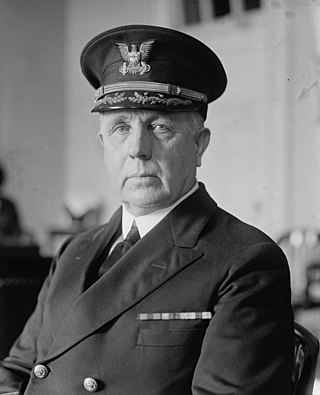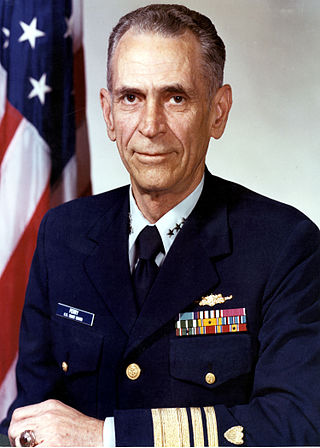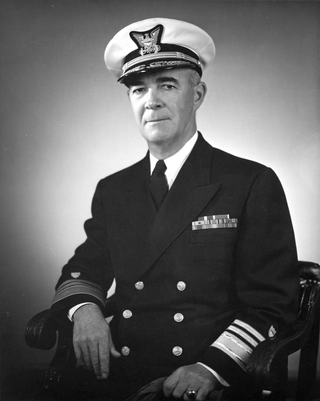Related Research Articles

The United States Coast Guard Academy (USCGA), located in New London, Connecticut, is the U.S. service academy specifically for the United States Coast Guard. Founded in 1876, the academy provides education to future Coast Guard officers in one of nine major fields of study.

Merlin O'Neill served as the tenth Commandant of the United States Coast Guard from 1 January 1950 to 1 June 1954.

Russell Randolph Waesche, Sr. served as the eighth Commandant of the United States Coast Guard from 1936 to 1946, overseeing the service during World War II. He was the U.S. Coast Guard's longest serving commandant, having served ten years in that post. In addition, he was the first officer to hold the ranks of vice admiral and admiral within the Coast Guard.

Harry Gabriel Hamlet was the seventh Commandant of the United States Coast Guard, from 1932 to 1936.

Frederick Chamberlayne Billard served as the sixth Commandant of the United States Coast Guard from 1924 until his death. Billard's military career began with his appointment to the School of Instruction of the Revenue Cutter Service in 1894. Among his experiences before becoming Commandant, Billard commanded several cutters, served as aide to two Commandants and also served twice as superintendent of the Coast Guard Academy. After rising through the ranks, he was appointed to serve as Commandant in January 1924 and with the appointment, the rank of rear admiral. His leadership of the Coast Guard during the Prohibition era required careful planning and use of available resources to accomplish the mission while making sure that other required missions were not slighted. He was very involved in the training of his officers as a superintendent of the United States Coast Guard Academy and he was responsible for the purchase of the permanent location of the academy at New London, Connecticut. Because of his emphasis on training, formalized coursework for enlisted personnel and standardized testing procedures for advancement in rating occurred while he was Commandant. Billard was supportive of newly available technologies such as aircraft and radio communication in order to accomplish the mission. The Coast Guard's involvement in oceanography was instituted during his tenure. He emphasized integrity in the Coast Guard's dealings with the public and expected his officers and men to be honest in order to preserve the image of the Coast Guard. Shortly after his appointment to an unprecedented third term as Commandant, Billard died of pneumonia in May 1932.

William Edward Reynolds served as the fifth Commandant of the United States Coast Guard, from 1919 to 1924.

USS Bear was a dual steam-powered and sailing ship built with six-inch (15.2 cm)-thick sides which had a long life in various cold-water and ice-filled environments. She was a forerunner of modern icebreakers and had a diverse service life. According to the United States Coast Guard official website, Bear is described as "probably the most famous ship in the history of the Coast Guard."

Admiral Robert Joseph Papp Jr. is a retired admiral of the United States Coast Guard who served as the 24th commandant from 2010 to 2014. He led the largest component of the United States Department of Homeland Security, with 42,000 active duty, 8,200 Reserve, 8,000 civilian, and 31,000 Auxiliary personnel.

USCGC Bear (WMEC-901) is a United States Coast Guard medium endurance cutter. She was laid down August 23, 1979 and launched September 25, 1980 by the Tacoma Boatbuilding Company of Tacoma, Washington. She was commissioned February 4, 1983. She was named for USRC Bear (AG-29), a steam barquentine that was built in Scotland and served the United States Treasury Department in the United States Revenue Cutter Service's Alaskan Patrol.

Edward Hanson "Iceberg" Smith was a United States Coast Guard admiral, oceanographer, and Arctic explorer. He was born 29 October 1889 at Vineyard Haven, Massachusetts. He received a Ph.D. in oceanography from Harvard, and commanded the USCGC Marion and the USCGC Northland. Most famously, he commanded the Greenland Patrol, and led Coast Guard efforts to defend Greenland against the Germans in World War II. After retirement from the Coast Guard, he assumed the directorship of Woods Hole Oceanographic Institution.

Sandra Leigh Stosz is a retired United States Coast Guard Vice Admiral whose final active duty assignment was as Deputy Commandant for Mission Support. Previously, she was chosen by the Commandant of the United States Coast Guard, ADM Robert J. Papp to become the superintendent of the United States Coast Guard Academy in 2011. As such, she is the first woman to lead a United States service academy. At the time of her appointment to head the Coast Guard Academy, she was the Coast Guard's director of Reserve and leadership. Stosz was confirmed as a vice admiral in May 2015.
Lyndon Spencer was a Vice Admiral in the United States Coast Guard.
Harold G. Bradbury was a rear admiral in the United States Coast Guard.
Arthur B. Engel was a rear admiral in the United States Coast Guard. At different points in his maritime career, he served as Superintendent of the United States Coast Guard Academy at New London, Connecticut and as Superintendent of the United States Merchant Marine Academy at Kings Point, New York.
William J. Keester was a rear admiral in the United States Coast Guard.
Robert S. Lucas was a rear admiral in the United States Coast Guard.

Ellis L. Perry was a vice admiral and Vice Commandant of the United States Coast Guard.
Edward Thiele was a rear admiral in the United States Coast Guard.

Vice Admiral James Albert Hirshfield was the sixth Assistant Commandant of the United States Coast Guard. During World War II he was the commanding officer of the USCGC Campbell (WPG-32) during a battle with German U-boats, earning the Navy Cross.
Donald McGregor Morrison was a vice admiral in the United States Coast Guard who served as the eighth Vice Commandant of the United States Coast Guard from 1962 to 1964.
References
- ↑ "Vice Admiral James Pine, USCG" (PDF). United States Coast Guard. Retrieved 2014-04-28.
- ↑ "James Pine". Military Times.com. Archived from the original on 2014-04-29. Retrieved 2014-04-28.
- ↑ "Pine, James". ANCExplorer. U.S. Army. Retrieved 2020-10-21.